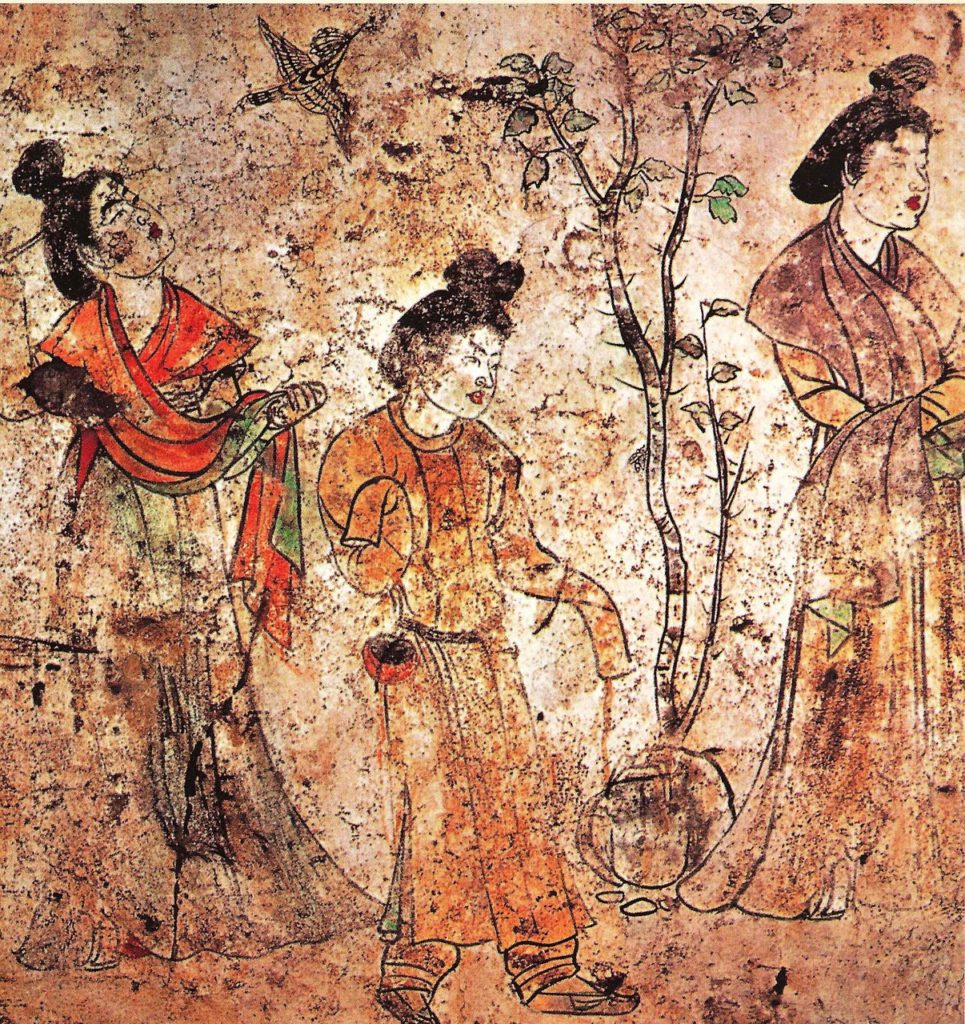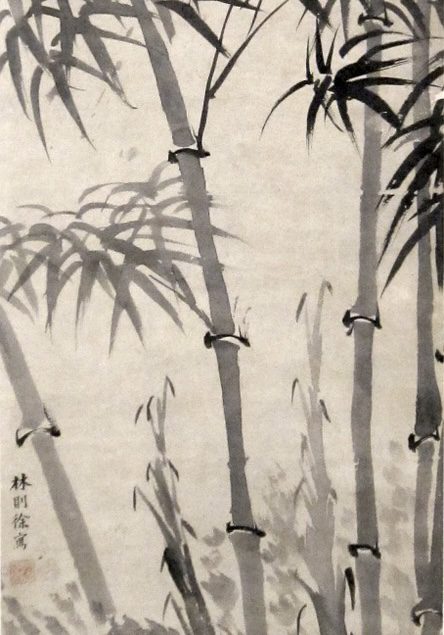Chinese ink artwork has a profound impact on the global art world. Since it is so old, it influences various artistic movements and inspires artists across different cultures. In this post, I will highlight the most important aspects of Chinese ink art, and how it got to where it is today.
Where Chinese Inking Started
Chinese ink artwork is often associated with ink wash painting or shuǐ mò huà (水墨画). It has a long history that dates back to ancient times, roughly around 4000–5000 years ago in China.
Ink art’s origins are deeply intertwined with the evolution of Chinese calligraphy. Both calligraphy and ink painting share similar materials and techniques. Historically, the earliest ink paintings are influenced by calligraphic strokes and techniques.
The development of ink art can be traced back to the Shang (c. 1600–1046 BC) and Zhou (c. 1046–256 BC) dynasties. However, ink art as a distinct form started to gain prominence during the Han Dynasty (206 BC–220 AD).
The Han Dynasty is when it truly became a bigger piece of culture and visual art.
Han Dynasty’s Influence (206 BC – 220 AD):
During the Han Dynasty, artists begin to use brush and ink to create landscape and figure paintings. Paper making and advancements in ink production and brush-making techniques contributed to the growth. There is refinement of ink painting as a standalone art form.
The Han Dynasty (206 BC – 220 AD) holds significant importance in the history of Chinese ink art. This is due to several key factors:
- Emergence of Early Ink Painting: The Han Dynasty saw the initial development of ink painting in Chinese art. Artists began experimenting with ink and brush. They gradually move from purely calligraphic works to early forms of monochromatic painting. However, it was not detailed and almost portrayed cartoon like forms.
- Influence on Subsequent Dynasties: Explorations in ink art during the Han Dynasty laid the groundwork for future developments in painting techniques. These early expressions of ink art influenced later periods and dynasties. This sets the stage for the evolution of Chinese ink painting.
- Enhancements in Ink Production: Advancements in ink production and refinement of ink-making techniques occurred during the Han Dynasty. Also, this led to improvements in the quality of ink sticks. This enabled artists to produce finer ink for both calligraphy and painting.
- Artistic Experimentation: Han artists began to experiment with brushwork, ink tones, and techniques to create landscapes, portraits, and scenes from daily life. These explorations, though less detailed and refined compared to later periods. They are instrumental in establishing the foundation for the development of Chinese ink art.
Techniques that were used in the Han Dynasty:
- Minimal Use of Color: Han Dynasty painting primarily relied on monochromatic ink techniques, with limited use of color. Artists explored tonal variations using different ink tones to create depth and form.
- Simple and Sparse Compositions: Artworks during this period tended to feature simpler and sparser compositions, focusing on conveying essential elements rather than intricate details.
- Influence from Calligraphy: The techniques used in early ink art during the Han Dynasty were closely related to calligraphy. Artists often utilized calligraphic brushwork to create lines and forms in their paintings.
After the Han Dynasty, other developments were made
In particular, the Tang Dynasty really took off with artistic advancements. In addition, this was after the foundation is laid from the Han Dynasty were using ink and a brush for things other than writing words.
The Tang Dynasty’s Influence (618–907 AD):
Some key advancements in painting during the Tang Dynasty include:
- Landscape Painting: Landscape painting flourished during the Tang Dynasty. Artists paid more attention to natural scenery, focusing on mountains, rivers, and forests. They explored various techniques to depict landscapes, introducing new methods for portraying the natural world.
- Figure Painting: The Tang Dynasty saw advancements in figure painting. Artists paid attention to human figures, depicting them with more naturalism and realism. Court scenes, portraits, and depictions of daily life became more detailed and refined.
- Court Patronage: The imperial court played a crucial role in fostering the arts. Artists received patronage and support from the ruling elite, leading to an environment that encouraged artistic expression and creativity.
- Cultural Exchange: The Tang Dynasty was open to cultural exchange with regions such as Central Asia, India, and beyond. This exchange of ideas and art forms contributed to the diversity and richness of artistic expression during this period.
- Integration of Ink and Color: While ink remained a significant medium, the Tang Dynasty witnessed the gradual integration of ink and color in painting. Artists began combining ink and color in court and Buddhist art. If you look at tang dynasty artwork, you’ll notice the transition in color here.
- Poetic Influence: Tang poetry had a profound influence on painting. Artists often drew inspiration from classical poems, combining visual and literary elements in their artwork.
The Tang Dynasty’s artistic achievements and innovations, particularly in ink art, landscape painting, and cultural exchange, laid the foundation for future developments in Chinese art. This period remains an influential era in Chinese art history. It fosters artistic expression and creativity that continued to evolve in subsequent dynasties.

The Song Dynasty’s Influence (960-1279 AD):
The Song Dynasty (960–1279 AD) in China was a period of great artistic achievement. Also, there was significant advancements and innovations in Chinese ink artwork. Some key advancements in ink art during the Song Dynasty include:
- Emphasis on Detail and Realism: Artists during the Song Dynasty paid more attention to detail and realism in their ink paintings. Landscape paintings became more intricate and detailed, showcasing a higher level of technical skill and precision.
- Literati Culture Influence: Ink art became closely associated with literati culture. Scholars, poets, and artists integrated their literary pursuits with painting. Also, the literati culture emphasized the idea of expressing personal emotions and individuality in artwork.
- Bird-and-Flower Painting: Song artists excelled in bird-and-flower painting, depicting birds, flowers, and other elements of nature with great attention to detail, often in a realistic and delicate manner.
- Monochrome Landscapes: The Song Dynasty saw a significant rise in the popularity of monochrome landscape painting. Artists depicted landscapes using only black ink, focusing on the power of ink tonality and brushwork to evoke emotional and atmospheric landscapes.
- Technical and Material Advancements: Advances in papermaking techniques and ink production contributed to the refinement of ink art. Higher-quality papers allowed for more sophisticated brushwork and ink application.
- Cultural Exchange and Influence: The Song Dynasty witnessed cultural exchange and interaction with neighboring regions, influencing and being influenced by art from regions such as Japan and Korea.
The Song Dynasty’s contributions to ink art marked a period of refinement, innovation, and sophistication in Chinese painting techniques. This era remains influential in the history of Chinese art, with its advancements continuing to shape and inspire ink painting practices.

Different techniques that were used in the Song Dynasty:
- Monochrome Landscapes: A notable development in Song Dynasty ink painting was the emphasis on monochrome landscapes. Artists used only black ink to create landscapes, exploring the tonal variations and expressive potential of ink washes.
- Fine Brushwork: Song artists paid great attention to detailed brushwork. They utilized precise and delicate brushstrokes to depict fine lines, textures, and details within their paintings, particularly in bird-and-flower compositions.
- Integration of Calligraphy and Painting: The Song Dynasty saw a strong connection between calligraphy and painting. Artists often combined calligraphic brushwork with their painting techniques, seeking to harmonize the two art forms.
- Bird-and-Flower Painting: The Song Dynasty excelled in bird-and-flower painting. Artists depicted birds, flowers, and other elements of nature with great attention to detail, often in a realistic and delicate manner.
- Literati Culture Influence: The literati culture during the Song Dynasty emphasized the personal and expressive elements in artwork. Artists sought to reflect individual emotions and aesthetic sensibilities in their paintings.
The Yuan Dynasty’s Influence (1271–1368 AD):
One of the main points of significance for the Yuan Dynasty was the change of cultural norms with Mongol Rule. Also, this period witnessed a significant influx of foreign cultural influences. This includes Mongol and Tibetan art. This exchange influenced and diversified Chinese artistic practices, including ink art.
- Introduction of New Subject Matter: Ink art during the Yuan Dynasty began to depict new subjects and themes. Artists explored narrative and figurative elements more prominently, departing from the traditional emphasis on landscapes and nature. Storytelling within ink paintings became more common.
- Innovation in Painting Techniques: Yuan artists experimented with new brushwork techniques, ink application, and tonal variations. These technical advancements led to a diversification of ink painting styles and approaches.
- Expansion of Artistic Styles: The period sees a departure from conventional ink art styles, allowing for the exploration of diverse artistic styles and expressions. Artists fused different techniques and cultural elements, leading to a broader diversity of artistic expression within ink painting.
- Legacy of Cross-Cultural Interaction: The interaction with different cultures laid the groundwork for future artistic developments. The exposure to diverse artistic traditions during the Yuan Dynasty provided a basis for continued experimentation and fusion of cultural influences in later periods.
The different techniques that were used in the Yuan Dynasty:
- Line and Wash Technique: Artists often combined calligraphic brushwork with washes of ink. This technique involved using expressive, calligraphic brushstrokes alongside varying degrees of ink washes to create both form and texture.
- Dry Brush Technique: Artists used a dry brush with minimal ink to create softer, less defined lines and textures. This technique added subtlety and a sense of depth to the painting by varying the tonal values.
- Outline and Fill Technique: Yuan artists utilized techniques involving both outlining forms and filling them in with ink washes. By using varied line weights and ink tones, they delineated forms and then filled them in with different intensities of ink washes to create volume and depth.
- Use of Negative Space: Artists paid attention to the concept of negative space. Leaving areas unpainted or less detailed was considered as crucial as the painted parts. This technique creates a sense of balance and harmony in the composition.
- Wet-on-Wet Technique: Artists applied wet ink on wet paper, allowing the ink to blend and spread, creating softer edges and gradations of tone.
- Narrative and Figurative Techniques: The Yuan Dynasty witnesses an increased focus on narrative and figurative elements. Artists developed techniques to depict storytelling within ink paintings, exploring new subject matter and themes.
Modern Day Chinese Ink Art
Nowadays, China is very immersed in other cultures. This means that there is more room for inspiration from exterior factors.
Modern Chinese ink art incorporates influences from Western art movements and techniques. Artists merge traditional ink techniques with Western artistic approaches. This is creating a fusion of styles.
